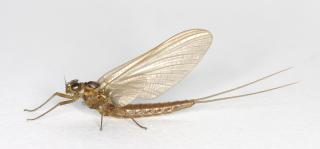Identifying ecosystem services provided by freshwater insects
Published on 8 February 2016 in Ecosystems and biodiversity

Introduction
Biodiversity conservation is increasingly framed within the ecosystem services concept. That can result in some taxa being overlooked, either because their contribution to ecosystem goods and services is small, has a non-monetary value or is unknown. Identifying which components of biodiversity contribute the most to ecosystem function and service delivery is a necessary first step in linking species diversity and ecosystem goods and services. Consideration of insect-related ecosystem services has largely focussed on terrestrial taxa while those inhabiting freshwater have been neglected. However, freshwater insects are fundamental to processes such as decomposition and nutrient cycling.
In Scotland, freshwater ecosystems cover around 2% of the land area with our lochs and rivers containing 90% of the UK’s surface freshwater. Freshwater insects can be extremely abundant and species rich. However, around 25% of freshwater invertebrate species are under threat of extinction worldwide including several Scottish species such as the Northern summer mayfly (Siphlonurus alternatus). A decline or loss of specific species and overall species richness is likely to lead to adverse effects on the delivery of services. For example, loss of species could result in a change in the mean level of service delivery, or more likely, the resilience of the system to perturbation. To ensure that the services provided by these insects are available to future generations, we need to ensure that freshwater insect populations are suitably resilient to threats from pollution, habitat loss and degradation. The identification of goods and services may bring greater appreciation and impetus to understanding the scale of their importance, economic value, and conservation.
Key Points
- The ecosystem services and benefits provided by freshwater insects are diverse and unexpectedly wide-ranging covering all four categories of services: provisioning, supporting, regulating and cultural. Several of these have clear economic values but are not currently fully exploited and there is considerable potential for future development.
- Silk sericins produced by caddis flies (Trichoptera) contain proteins which have antioxidant, moisturising and UV-shielding properties, and are used as additives in cosmetic products. Many freshwater insects have higher chitin contents than commercially exploited crustaceans. Chitin is used in the biomedical, pharmaceutical and cosmetic industries.
- The breakdown and decomposition of organic matter in freshwater systems is strongly dependent on specific insect groups and their abundance. Their feeding activities therefore contribute to nutrient flows and cycling. Filter-feeders such as blackflies (Diptera) improve water quality by removing microscopic particles, such as cellular algae. Net-spinning caddisfly larvae contribute to the stability of fine-gravel due to the binding of grains by silk strands. Burrowing species aerate and rework sediments further influencing biogeochemical processes.
- Contribution to the diets of fish is arguably the most economically important ecosystem service provided by freshwater insects and around two-thirds of their predators are fish species. However, they are important prey for a wide range of other invertebrates, reptiles, amphibians, mammals (e.g. bats) and birds. Freshwater insects also contribute to the survival of species higher up the food chain. For example, to fish-eating otters.
- The adult stages of many freshwater insects, particularly damselflies and dragonflies, consume vast quantities of midges and mosquitoes that are otherwise a nuisance to humans. Hoverflies with aquatic larvae (e.g. Eristalis species) are important pollinators.
- Recreational fishing is dependent on freshwater insects to support healthy fish populations. In Scotland, freshwater fisheries for Salmon and Trout contribute over £112 million annually to the economy. Aquatic insects like stoneflies and mayflies are an essential source of food for such fish.
- Freshwater insects, particularly dragonflies and mayflies, have inspired and been the subject of books, paintings, jewellery, films (e.g. Jurassic Park), computer games (e.g. Spyro) and marketing campaigns (e.g. Vodafone in 2006). They have given their names to shoes, public houses, aeroplanes, musical outfits, cleaning products, homewares and food and drink products. The development of micro-helicopters and unmanned aerial vehicles draws heavily on the mechanics of dragonfly flight.
- In the absence of freshwater insects, few other service providers could replicate the same level and degree of service. The most serious consequences for freshwater habitats would be a build-up of organic matter or a decline in fish size or populations with repercussions further up the food chain.
Research Undertaken
This briefing is based on a formal review of academic literature and supplemented with grey and popular literature and resources. The review considered the ecosystem goods and services provided by freshwater insects globally, though only those relevant to Scotland are included in this briefing. Economic values were assigned purely on a low, medium or high categorical basis given the complexity of assigning more precise values to these goods and services. Services were assigned to categories using expert judgement and taking into account the contribution of the taxa in question compared to other providers of the same service. This research was supported by the Scottish Government’s RESAS Strategic Research Programme 2011-16.
Policy Implications
Freshwater management needs to be applied at the catchment scale. Freshwater sites are embedded within their watersheds and affected by upstream influences, and freshwater insects are dependent on a network of connectivity in order to aid migration and dispersal. Furthermore, threats such as diffuse pollution, sediment and non-native species can only be effectively tackled at a catchment scale. While freshwater and adjacent riparian habitats in Scotland are generally in good condition, and have been improved in recent years as a result of Directives such as the Water Framework Directive and agri-environment schemes, many freshwater insects are still in decline and pressures are only likely to increase. For example, we need to know what the impacts are of pesticides and pharmaceutical products on freshwater biota, and how multiple stressors will affect species persistence and service delivery.
Authors
Craig R. Macadam, Buglife Craig.MacAdam@Buglife.org.uk
Dr Jenni A. Stockan, James Hutton Institute jenni.stockan@hutton.ac.uk





